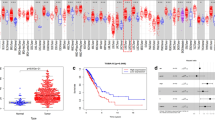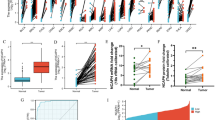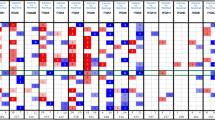Abstract
Objective
T cell receptor-associated transmembrane adaptor 1 (TRAT1) is one of the hub genes regulating T cell receptors (TCRs). Herein, the roles of TRAT1 in the prognosis and immune microenvironment of non-small cell lung cancer (NSCLC) were investigated.
Methods
The expression and prognosis values of TRAT1 in NSCLC, and the relationship between TRAT1 expression levels and cancer immune cell infiltration was identified via the TIMER, UALCAN, TISIDB, and other databases. The mechanism of TRAT1 in NSCLC was analyzed using gene set enrichment analysis (GSEA).
Results
The expression level of TRAT1 was decreased in NSCLC tissues. Low TRAT1 expression was associated with shorter overall survival of patients with NSCLC and was related to gender, smoking, and tumor grade. TRAT1 was involved in regulating immune response, TCR signaling pathway, PI3K/AKT, and other processes. TRAT1 expression levels were positively correlated with immune cell infiltration in NSCLC.
Conclusion
Down-regulation of TRAT1 expression was associated with an unfavorable prognosis and immune infiltration of NSCLC.
Similar content being viewed by others
References
Barrón-Barrón F, Guzmán-De Alba E, Alatorre-Alexander J, et al. National Clinical Practice Guidelines for the management of non-small cell lung cancer in early, locally advanced and metastatic stages. Salud Publica Mex, 2019,61(3):359–414
Siegel RL, Miller KD, Jemal A. Cancer statistics, 2020. CA Cancer J Clin, 2020,70(1):7–30
Bircan HA, Gurbuz N, Pataer A, et al. Elongation factor-2 kinase (eEF-2K) expression is associated with poor patient survival and promotes proliferation, invasion and tumor growth of lung cancer. Lung Cancer, 2018,124:31–39
Li Z, Xu X, Luo M, et al. Activator Protein-2β Promotes Tumor Growth and Predicts Poor Prognosis in Breast Cancer. Cell Physiol Biochem, 2018,47(5):1925–1935
Guo Q, Ke XX, Fang SX, et al. PAQR3 Inhibits Non-small Cell Lung Cancer Growth by Regulating the NF-κB/p53/Bax Axis. Front Cell Dev Biol, 2020,8:581919
Wang L, Hou Z, Hasim A, et al. RNF113A promotes the proliferation, migration and invasion, and is associated with a poor prognosis of esophageal squamous cell carcinoma. Int J Oncol, 2018,52(3):861–871
Yan X, Yu Y, Li L, et al. Friend leukemia virus integration 1 is a predictor of poor prognosis of breast cancer and promotes metastasis and cancer stem cell properties of breast cancer cells. Cancer Med, 2018,7(8):3548–3560
Xu X, Huang Z, Zheng L, et al. The efficacy and safety of anti-PD-1/PD-L1 antibodies combined with chemotherapy or CTLA4 antibody as a firstline treatment for advanced lung cancer. Int J Cancer, 2018,142(11):2344–2354
Zhang H, Dutta P, Liu J, et al. Tumour cell-intrinsic CTLA4 regulates PD-L1 expression in non-small cell lung cancer. J Cell Mol Med, 2019,23(1):535–542
Babteen NA, Fawzy MS, Alelwani W, et al. Signal peptide missense variant in cancer-brake gene CTLA4 and breast cancer outcomes. Gene, 2020,737:144435
Zheng X, Zhang N, Qian L, et al. CTLA4 blockade promotes vessel normalization in breast tumors via the accumulation of eosinophils. Int J Cancer, 2020,146(6):1730–1740
Liu K, Zhao K, Wang L, et al. The prognostic values of tumor-infiltrating neutrophils, lymphocytes and neutrophil/lymphocyte rates in bladder urothelial cancer. Pathol Res Pract, 2018,214(8):1074–1080
Wang R, Liu Y, Liu L, et al. Tumor cells induce LAMP2a expression in tumor-associated macrophage for cancer progression. EbioMedicine, 2019,40:118–134
Kirchgessner H, Dietrich J, Scherer J, et al. The transmembrane adaptor protein TRIM regulates T cell receptor (TCR) expression and TCR-mediated signaling via an association with the TCR zeta chain. J Exp Med, 2001,193(11):1269–1284
Tajbakhsh A, Pasdar A, Rezaee M, et al. The current status and perspectives regarding the clinical implication of intracellular calcium in breast cancer. J Cell Physiol, 2018,233(8):5623–5641
Zhang Y, Zhang T, Wu C, et al. ASIC1a mediates the drug resistance of human hepatocellular carcinoma via the Ca2+/PI3-kinase/AKT signaling pathway. Lab Invest, 2017,97(1):53–69
Endo H, Ikeda K, Urano T, et al. Terf/TRIMIT stimulates degradatiom of kinetochore protein ZWINT and regulates cell proliferation. J Biochem, 2012,151(2):139–144
Chandrashekar DS, Bashel B, Balasubramanya SAH, et al. UALCAN: A Portal for Facilitating Tumor Subgroup Gene Expression and Survival Analyses. Neoplasia, 2017,19(8):649–658
Wang DW, Yang ZS, Xu J, et al. Identification of Prognostic Genes for Colon Cancer through Gene Co-expression Network Analysis. Curr Med Sci, 2021,41(5):1012–1022
Zhang YQ, Tang MY, Guo Q, et al. The value of erlotinib related target molecules in kidney renal cell carcinoma via bioinformatics analysis. Gene, 2022,816:146173
Mizuno H, Kitada K, Nakai K, et al. PrognoScan: a new database for meta-analysis of the prognostic value of genes. BMC Med Genomic, 2009,2:18
Ru B, Wong CN, Tong Y, et al. TISIDB: an integrated repository portal for tumor-immune system interactions. Biomformatics, 2019,35(20):4200–4202
Li T, Fan J, Wang B, et al. TIMER: A Web Server for Comprehensive Analysis of Tumor-Infiltrating Immune Cells. Cancer Res, 2017,77(21):e108–e110
Li B, Yan C, Zhu J, et al. Anti-PD-1/PD-L1 Blockade Immunotherapy Employed in Treating Hepatitis B Virus Infection-Related Advanced Hepatocellular Carcinoma: A Literature Review. Front Immunol, 2020,11:1037
Mahn R, Vogt A, Kupczyk P, et al. Programmed cell death protein 1 (PD-1)-inhibition in hepatocellular carcinoma (HCC): a single center experience. Scand J Gastroenterol, 2020,55(9):1057–1062
Guo Q, Li D, Luo X, et al. The Regulatory Network and Potential Role of LINC00973-miRNA-mRNA ceRNA in the Progression of Non-Small-Cell Lung Cancer. Front Immunol, 2021,12:684807
Kim JW, Nam KH, Ahn SH, et al. Prognostic implications of immunosuppressive protein expression in tumors as well as immune cell infiltration within the tumor microenvironment in gastric cancer. Gastric Cancer, 2016,19(1):42–52
De Marchi E, Orioli E, Pegoraro A, et al. The P2X7 receptor modulates immune cells infiltration, ectonucleotidases expression and extracellular ATP levels in the tumor microenvironment. Oncogene, 2019,38(19):3636–3650
Autio M, Leivonen SK, Brück O, et al. Immune cell constitution in the tumor microenvironment predicts the outcome in diffuse large B-cell lymphoma. Haematologica, 2020,106(3):718–729
Chen YY, Feng Y, Mao QS, et al. Diagnostic and prognostic value of the peripheral natural killer cell levels in gastric cancer. Exp Ther Med, 2020,20(4):3816–3822
Garnelo M, Tan A, Her Z, et al. Interaction between tumour-infiltrating B cells and T cells controls the progression of hepatocellular carcinoma. Gut, 2017,66(2):342–351
Bruno TC, Ebner PJ, Moore BL, et al. Antigen-Presenting Intratumoral B Cells Affect CD4 TIL Phenotypes in Non-Small Cell Lung Cancer Patients. Cancer Immunol Res, 2017,5(10):898–907
Djenidi F, Adam J, Goubar A, et al. CD8+CD103+tumor-infiltrating lymphocytes are tumor-specific tissue-resident memory T cells and a prognostic factor for survival in lung cancer patients. J Immunol, 2015,194(7):3475–3486
Rotondo R, Barisione G, Mastracci L, et al. IL-8 induces exocytosis of arginase 1 by neutrophil polymorphonuclears in nonsmall cell lung cancer. Int J Cancer, 2019,125(4):887–893
Zhu Y, Yang J, Xu D, et al. Disruption of tumour-associated macrophage trafficking by the osteopontin-induced colony-stimulating factor-1 signalling sensitises hepatocellular carcinoma to anti-PD-L1 blockade. Gut, 2019,68(9):1653–1666
Mulati K, Hamanishi J, Matsumura N, et al. VISTA expressed in tumour cells regulates T cell function. Br J Cancer, 2019,120(1):115–127
Author information
Authors and Affiliations
Corresponding author
Ethics declarations
The authors declare no conflicts of interest.
Author Si-hua WANG is a member of the Young Editorial Board for Current Medical Science. The paper was handled by other editors and has undergone rigorous peer review process. Author Si-hua WANG was not involved in the journal’s review of, or decision related to, this manuscript.
Additional information
This study was supported by grants from the Natural Science Foundation of Hubei (No. 2020CFB392), and the National Natural Science Foundation of China (No. 82100115, No. 82100116 and No. 82070431).
Supplementary data
Rights and permissions
About this article
Cite this article
Guo, Q., Wang, Sh., Ji, Ym. et al. The Roles and Mechanisms of TRAT1 in the Progression of Non-Small Cell Lung Cancer. CURR MED SCI 42, 1186–1200 (2022). https://doi.org/10.1007/s11596-022-2625-1
Received:
Accepted:
Published:
Issue Date:
DOI: https://doi.org/10.1007/s11596-022-2625-1




